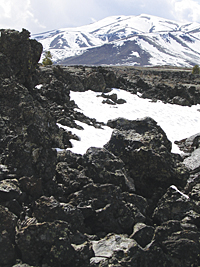"Sort of like opening up a tub of cookies-and-cream ice cream."
That's how Ted Stout describes winter at Craters of the Moon National Monument, about 25 miles east of Carey. It is a massive preserve—roughly the size of Rhode Island at 750,000 acres—of lava flows interspersed with cinder cones and sagebrush fields.
"It's really quite beautiful in the winter," said Stout, who's the chief of interpretation at the preserve. "And this is kind of the calm season as far as wind is concerned."
Volcanic eruptions 2,000 to 15,000 years ago formed more than 60 lava flows and 25 cones in the preserve. The Great Rift, a system of fractures in the earth's crust that begins at the base of the Pioneer Mountains and extends more than 50 miles to the southeast, also runs through the preserve. The area supports the most complex of the late Pleistocene and Holocene basaltic lava fields in the eastern Snake River Plain and the largest lava field of its type in the contiguous United States.
But not all of the landscape was smothered by lava. Areas of higher ground remained undisturbed, creating islands of vegetation called "kipukas," Hawaiian for windows. According to the Bureau of Land Management, kipukas now support some of the last pristine vegetation in the Snake River Plain, including 700-year-old juniper trees.
The latest volcanic eruptions are also the source of Shoshone Indian legend, according to the BLM, which manages part of the preserve. As the story goes, a large serpent angered by lightning coiled itself around a mountain until it exploded with fire and liquid rock, creating the lava fields.
The park might not provide classic Christmas imagery, but Stout did joke that snow-covered limber pines dotting the lunar landscape "look very festive."
Actually, Craters can be a winter wonderland, and with black rock sparkling under a fresh blanket of snow offers a unique alternative to the alpine environment engulfing the Wood River Valley.
"The contrast of the white snow and the black rock and being able to see out for great distances from the edges of the cinder cones is quite a unique experience," Stout said. "Where else can you summit the cinder cone of a volcano."
The loop drive is closed to automobiles in the winter, but other opportunities abound.
When there's enough snow—usually by early January—the preserve offers seven miles of groomed Nordic skiing and a massive expanse of snowshoeing opportunities.
"For the first time this year, we'll mark a one-mile loop trail for snowshoeing with orange poles and people will be able to follow that route," Stout said. "But folks are welcome to go wherever they want. You're better off on the cinder cones instead of the lava because there are all kinds of cracks in the lava itself."
A host of winter activities are also available this season.
Beginning in January, winter ecology workshops will be held every Saturday—except Jan. 13—through Feb. 17. The workshops, which are free and will run from 9:30 a.m. to 4:30 p.m., are designed to explore a different side of the preserve. Following an hour-long classroom session, participants will be guided out into the field for several hours of snowshoeing and instruction. Snowshoes will be supplied free of charge. Reservations are required and participants must be 10 years of age since the walk is somewhat strenuous.
"We usually climb up to the top of one of our cones here—where you have a great view—and discuss some ecology principles in the field," Stout said. "We also have a shorter version for school kids."
That version, known as Snowschool, will also begin in January and will be offered every Wednesday and Thursday through February. The school, which includes winter ecology lessons on a one-mile ranger-led trip near the visitors center, is for third-graders and up.
"It's a really fun field trip for the kids," Stout said. "They really enjoy doing it. It's a great learning experience for them."
The preserve can supply snowshoes for up to 30 students.
Teachers can also take a two-day Snowschool workshop to learn winter ecology lessons that can be used in the classroom or the field. The class will be held Jan. 13 and 14.
For more information on the preserve and its programs, call (208) 527-3257.


 Craters of the Moon National Monument is a land of sharp contrasts, especially in winter. Photo by Greg Stahl
Craters of the Moon National Monument is a land of sharp contrasts, especially in winter. Photo by Greg Stahl



































